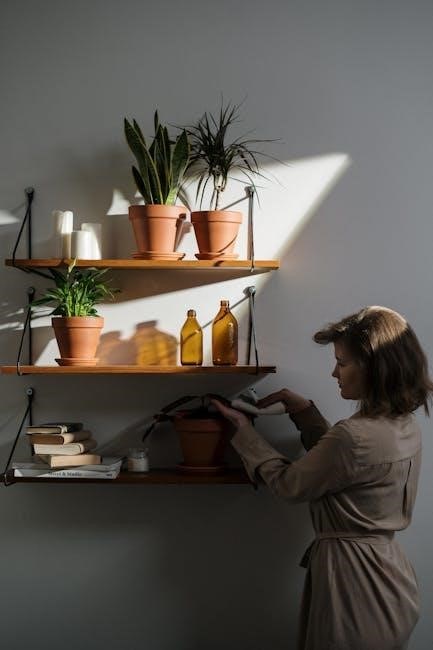Air plants are unique, low-maintenance epiphytes that thrive without soil. They require proper light, water, and air circulation to survive. This guide provides essential tips for their care.
What Are Air Plants?
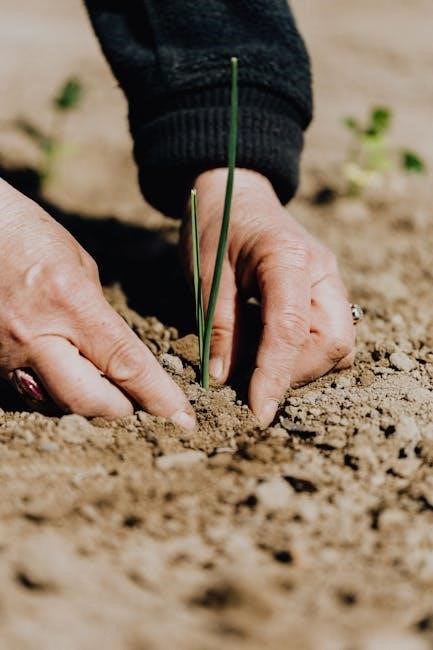
Air plants, scientifically known as Tillandsia, are epiphytes that grow without soil, absorbing moisture and nutrients through their leaves. Native to tropical and subtropical regions, they thrive on surfaces like trees or rocks. These unique plants require bright light, air circulation, and regular watering to survive. Unlike traditional plants, air plants don’t need soil, making them popular for indoor gardening. They are low-maintenance and versatile, growing on various surfaces. With proper care, air plants can bloom vibrant flowers, adding beauty to any space. Understanding their needs is key to keeping them healthy and thriving in a home environment.
Why Air Plants Are Unique
Air plants are unique due to their ability to thrive without soil, relying on their leaves to absorb moisture and nutrients. Their specialized leaf structures, covered in tiny hair-like scales called trichomes, allow them to capture and retain water and nutrients from the air. This adaptation makes them epiphytes, capable of growing on surfaces like branches or rocks. Unlike most plants, air plants don’t require soil, making them ideal for decorative arrangements. They also produce vibrant, long-lasting flowers, adding aesthetic appeal. Their low-maintenance care and versatility in growth environments make air plants a popular choice for indoor gardening enthusiasts. This unique combination of traits sets them apart from traditional plants.

Understanding the Basics of Air Plant Care
Air plants require light, water, and air circulation to thrive. Understanding these basics ensures their survival and promotes healthy growth in any indoor environment.
Light Requirements for Air Plants
Air plants thrive in bright, indirect light but should be protected from direct sunlight, which can cause burning. Placing them near an East- or West-facing window is ideal, as it provides gentle, filtered light. Avoid North-facing windows, as they may not receive enough light for optimal growth. South-facing windows can work if filtered with a sheer curtain to prevent intense sun exposure. Air plants naturally grow under dappled light in their tropical habitats, so replicating this condition indoors ensures their well-being. Inadequate light can lead to slower growth and fewer blooms, while excessive light can damage their leaves. Balance is key to maintaining their health and vibrancy.
Watering Needs and Techniques
Air plants require consistent watering to thrive. The most effective method is submerging the entire plant in room-temperature water for 5-10 minutes, 1-2 times a week. After soaking, gently shake off excess water and place the plant in a well-ventilated area to dry completely. Mistings between soaks can supplement moisture, especially in dry climates. Avoid using distilled water, as it lacks beneficial minerals; tap or rainwater is ideal. Over-watering can lead to root rot, so ensure the plant dries fully within 4-6 hours. Proper watering balance is crucial for healthy growth and bloom production. Regular attention to moisture levels will keep your air plant vibrant and flourishing year-round.

Importance of Air Circulation
Air circulation is vital for air plants to thrive. Native to tropical climates, these epiphytes grow on trees with natural airflow, preventing moisture buildup. Proper air circulation ensures plants dry fully after watering, reducing the risk of rot. Without adequate airflow, excess water can linger, leading to decay. Place air plants near windows or use fans to enhance air movement. Avoid overcrowding, as this restricts airflow and increases humidity. Good air circulation promotes healthy roots and prevents fungal growth. It’s essential for maintaining the plant’s natural balance and ensuring long-term survival. Regularly inspect your plants to ensure they’re drying properly, and adjust their placement if necessary for optimal air flow.
Essential Care Requirements
Air plants need bright, indirect light, proper watering, and good air circulation. Weekly soaking and misting are recommended, ensuring they dry fully to prevent rot and thrive.
Light Exposure: Direct vs. Indirect Sunlight
Air plants thrive in bright light but typically require indirect sunlight. Direct sun can cause leaves to become scorched, especially in warmer climates. East- or west-facing windows are ideal for providing gentle, filtered light. South-facing windows can work if shaded with a sheer curtain to avoid direct rays during peak hours. Avoid placing air plants in low-light areas, as this can lead to weak growth and reduced color vibrancy. In tropical environments, where air plants naturally grow under tree canopies, replicating dappled light ensures optimal health. Proper light exposure is crucial for photosynthesis and maintaining their unique appearance.
Watering Frequency and Methods
Air plants should be watered once or twice a week, depending on humidity and temperature. Submerge the plant in room-temperature water for 5-10 minutes. Gently shake off excess water to prevent rot. For misting, use a spray bottle 2-3 times weekly, focusing on the base and leaves. Rain or pond water is ideal, but tap water works if left to sit for 24 hours. Avoid chlorine, which can harm the plants. Ensure air plants dry within 4-6 hours post-watering to prevent moisture buildup; Proper watering techniques are essential for their survival and thrive, ensuring they receive adequate hydration without succumbing to overwatering issues.
Temperature and Humidity Levels
Air plants thrive in temperatures between 50-90°F (10-32°C), with optimal growth in warmer, humid environments. They prefer average humidity levels of 40-60%, mirroring their natural tropical habitats. To maintain humidity, place plants on trays with water and pebbles or use a humidifier. Avoid placing them near heating vents or drafty windows, as sudden temperature drops can stress the plants. In drier climates, misting 2-3 times weekly helps maintain moisture. Ensure good air circulation to prevent moisture buildup, which can lead to rot. By balancing temperature and humidity, air plants will remain healthy and vibrant, adapting well to indoor conditions with proper care.
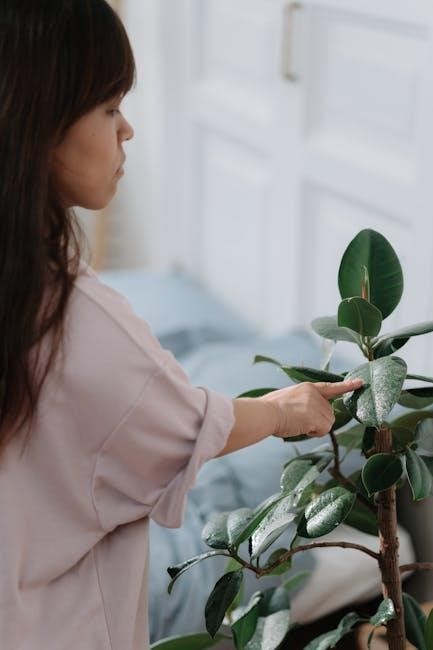
Advanced Care Tips
For optimal health, rotate air plants regularly to ensure even light exposure. Fertilize monthly with a water-soluble bromeliad or orchid fertilizer during the growing season.
Fertilizing Air Plants
Air plants benefit from occasional fertilization to promote healthy growth and blooming. Use a water-soluble bromeliad or orchid fertilizer, diluting it to half the recommended strength. Fertilize monthly during the growing season (spring and summer) by misting the leaves or soaking the plant in the fertilizer solution for 1-2 hours. Avoid over-fertilizing, as this can damage the plant. After fertilizing, rinse the plant thoroughly with fresh water to prevent nutrient buildup. Proper fertilization enhances color, bloom production, and overall vitality. Always follow the product’s instructions and adjust based on your plant’s response. This simple step can make a significant difference in the health and beauty of your air plants.
Pruning and Grooming
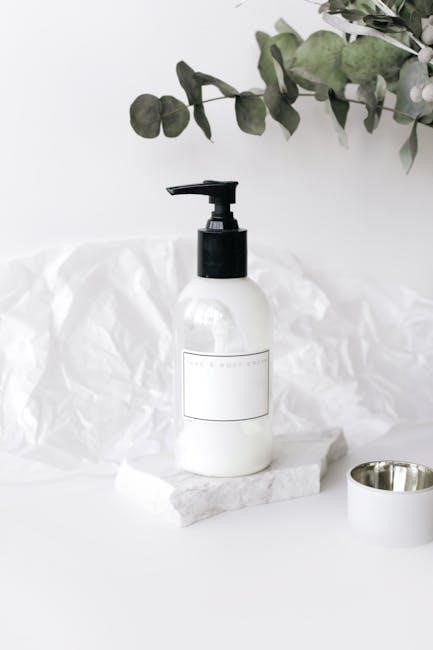
Pruning and grooming are essential for maintaining the health and appearance of air plants. Remove dead or dying leaves and flowers by gently trimming them with clean, sharp scissors or tweezers. This helps prevent the spread of decay and encourages new growth. Regular grooming also improves air circulation around the plant, which is crucial for its survival. After watering, inspect your air plant for any discolored or wilted parts and remove them promptly. For flowering air plants, dead blooms can be carefully snipped off to redirect energy to the foliage. Prune sparingly to avoid stressing the plant, and always handle it gently to avoid damage. Regular grooming ensures your air plant remains vibrant and thrives in its environment.
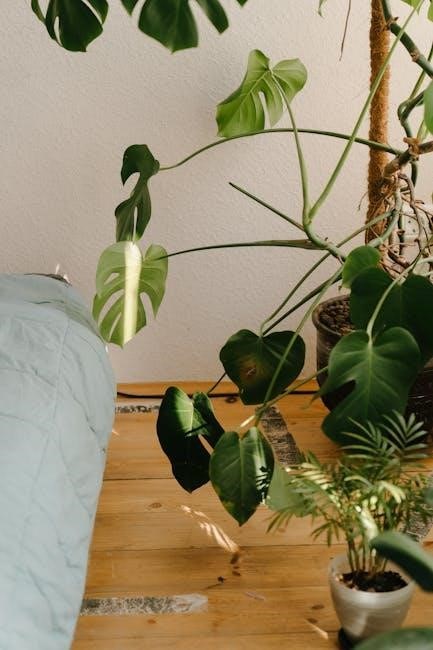
Troubleshooting Common Issues
Air plants may face issues like under-watering (brittle leaves) or over-watering (rot at the base). Adjust watering frequency and ensure proper air circulation to resolve these problems.
Signs of Under-Watering
Under-watering is common in air plants, causing leaves to become brittle, curled, or discolored. They may turn a dull gray or brown, losing their natural vibrancy. If neglected, the plant may stop growing or shed leaves excessively. It’s important to recognize these signs early, as prolonged dehydration can lead to irreversible damage. Ensure your air plant receives adequate moisture through regular soaking or misting, especially in dry environments. Proper hydration will restore their plump, colorful appearance and maintain their health. Always check your plant’s condition after watering to avoid further stress.
Signs of Over-Watering
Over-watering is a common issue that can severely damage air plants. Signs include soft, mushy, or discolored leaves, often turning black or brown at the base. The plant may develop root rot, causing it to decay. Excess water pooling in the leaves or at the plant’s center is a clear indicator of overhydration. If left unchecked, the plant may lose its ability to absorb nutrients, leading to wilting or death. Ensure proper drainage and avoid leaving water in the crown for extended periods. Regularly inspect your air plant for these signs and adjust your watering routine to prevent further damage.
Air plant care is straightforward with proper attention to light, water, and circulation. For detailed guides, explore “Air Plant Care Instructions PDF” and specialist tillandsia resources online.
Final Tips for Successful Air Plant Care
Consistency is key to thriving air plants. Ensure they receive bright, indirect light and proper watering. Rotate plants regularly for even growth. Avoid direct sunlight and overwatering.
Recommended Reading and Guides
For a deeper understanding of air plant care, explore comprehensive guides and resources. Look for detailed PDFs or e-books that focus on Tillandsia species, covering topics like watering techniques, light requirements, and air circulation. Many botanical gardens and horticultural websites offer free downloadable guides. Additionally, check out community forums and plant enthusiasts’ blogs for shared experiences and tips. Reputable sources often include step-by-step care instructions and troubleshooting advice. These resources will help you refine your care routine and ensure your air plants thrive. Remember to cross-reference information to confirm best practices for your specific species.

